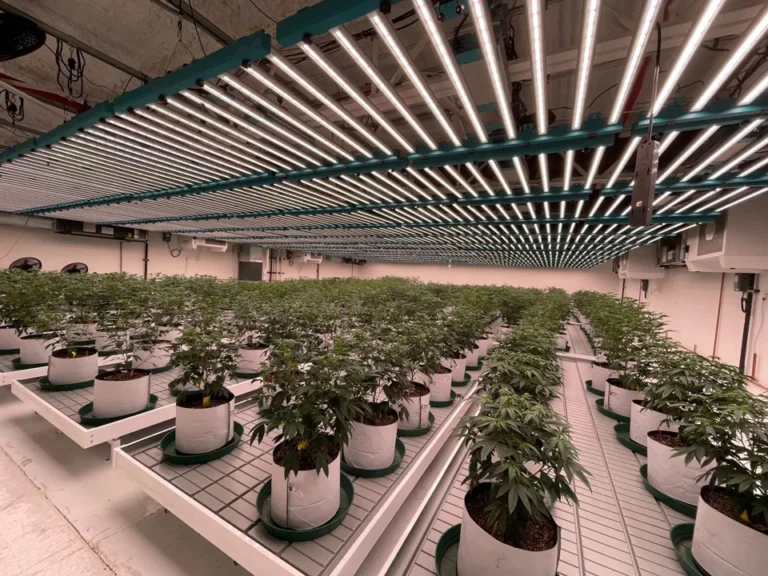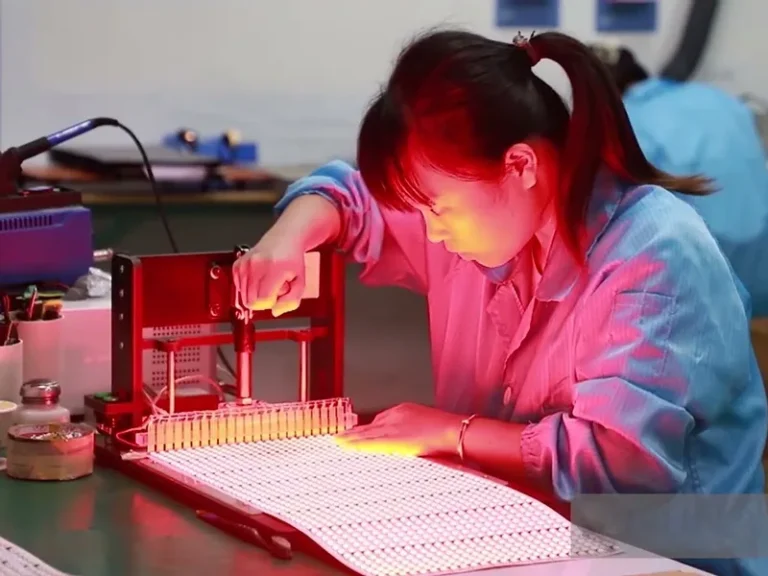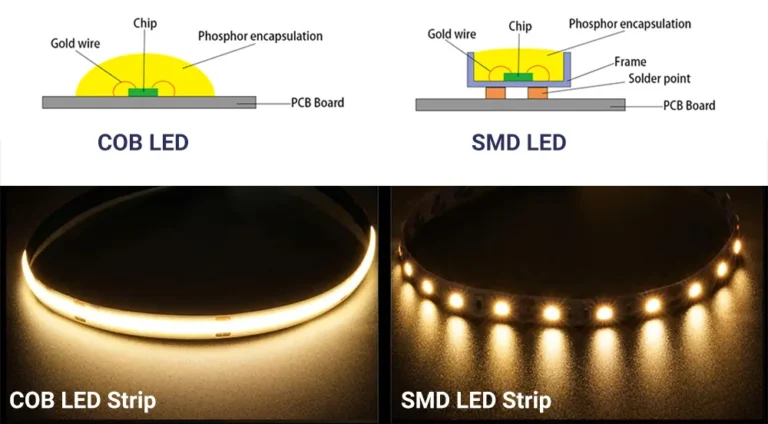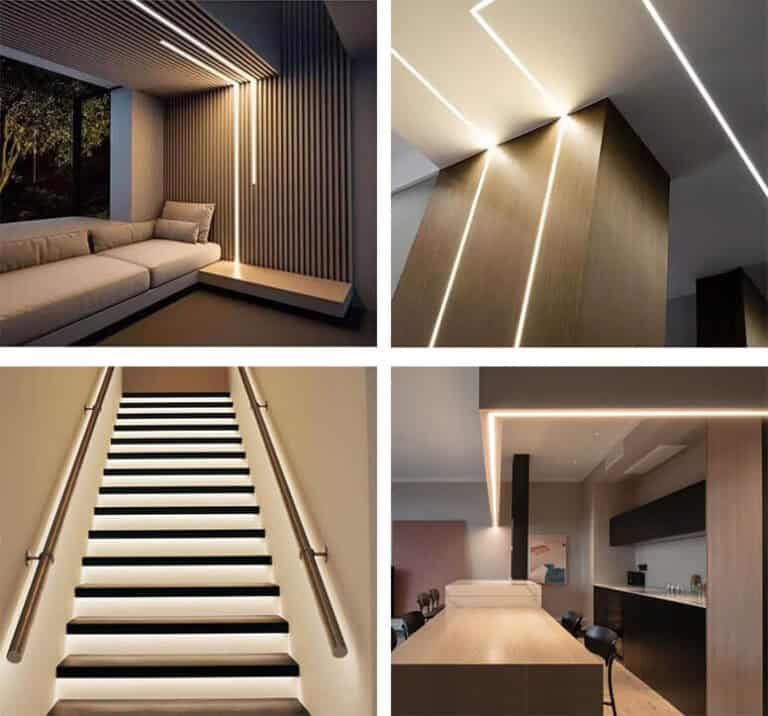In the current market, there are numerous LED plant lighting products available, and their appearances may be similar. However, there are significant differences in their actual performance, primarily in terms of short lifespan, with some products failing after just a few dozen hours of use or experiencing severe light decay within their specified lifespan, and initial light intensity output failing to meet the product’s stated specifications. Therefore, selecting a qualified and reliable product has become an important consideration for many users.
This article takes LED grow lights for indoor green leafy plants as an example to introduce some basic knowledge about plant lights and how to reasonably configure the spectrum, providing users with parameters to consider when comparing different products. It is hoped that this information will assist users in making their selections.
What are PAR, PPFD, and PPF?
PAR (Photosynthetic Active Radiation) refers to radiation within a specific wavelength range (400-700 nm) that plants use for photosynthesis. The wavelength range to which plants are sensitive to light differs from that to which the human eye is sensitive, and the units used to describe light intensity are also different. The human eye is more sensitive to yellow-green light, with light intensity measured in lumens and lux. Plants are more sensitive to red and blue light, with light intensity measured in μmol/s and μmol/m²/s.
Plants primarily utilize light in the 400-700 nm wavelength range for photosynthesis, and this wavelength range is what we commonly refer to as photosynthetically active radiation (PAR). PAR has two units: one is photosynthetic irradiance (w/m²), primarily used for studying photosynthesis under sunlight; the other is photosynthetic photon flux density (PPFD) (μmol/m²/s), primarily used for studying the effects of artificial light sources and sunlight on plant photosynthesis.
PPFD represents the number of photons per second (PAR) within a specific illuminated plane, i.e., the density of photosynthetic photon flux, with units of μmol/m²/s. It is a key indicator for evaluating the actual lighting effect of a plant lighting system on plants, as it directly impacts photosynthesis and plant growth. As shown in the figure below, the number of photons per second within a 1 m² plane is 33 μmol/m²/s.

PPF (photosynthetic photon flux) refers to the unit of light intensity in photosynthesis, specifically the number of photons per unit area per unit time within the photosynthetically active radiation (PAR) range (400–700 nm wavelength). Under the same power conditions, the higher the number of photons emitted per second by the light source (i.e., the higher the μmol/s value), the higher the luminous efficiency and the more energy-efficient the lighting fixture. The unit of photosynthetic photon flux is the number of photons per second, typically denoted as μmol/s.
| Plant lighting parameters | Unit | General lighting parameters | Unit |
| Photon flux(PPF) | μmol/s | luminous flux | Lumen |
| Photon flux efficiency(η) | μmol/S/W | light source | Lm/W |
| Photon flux density(PPFD) | μmol/㎡/s | illuminance | Lux(lm/㎡) |
PAR measures the radiation energy utilized by plants for photosynthesis; PPF measures the total number of photosynthetic photons emitted by the light source per second, but it does not directly indicate whether these photons reach the plant surface. PPFD (photosynthetic photon flux density) is crucial in plant lighting because it not only measures the overall photon output of the lighting system but also evaluates the impact of different light sources on plant growth. Higher PPFD correlates with higher photosynthetic rates and increased plant yield; PPFD is used to assess the actual light intensity reaching the plants and is a key indicator for optimizing plant growth environments.
The attached figure shows the test report for the 1000W foldable LED grow light produced by SignliteLED, with a PPF of 2895.35 μmol/s.
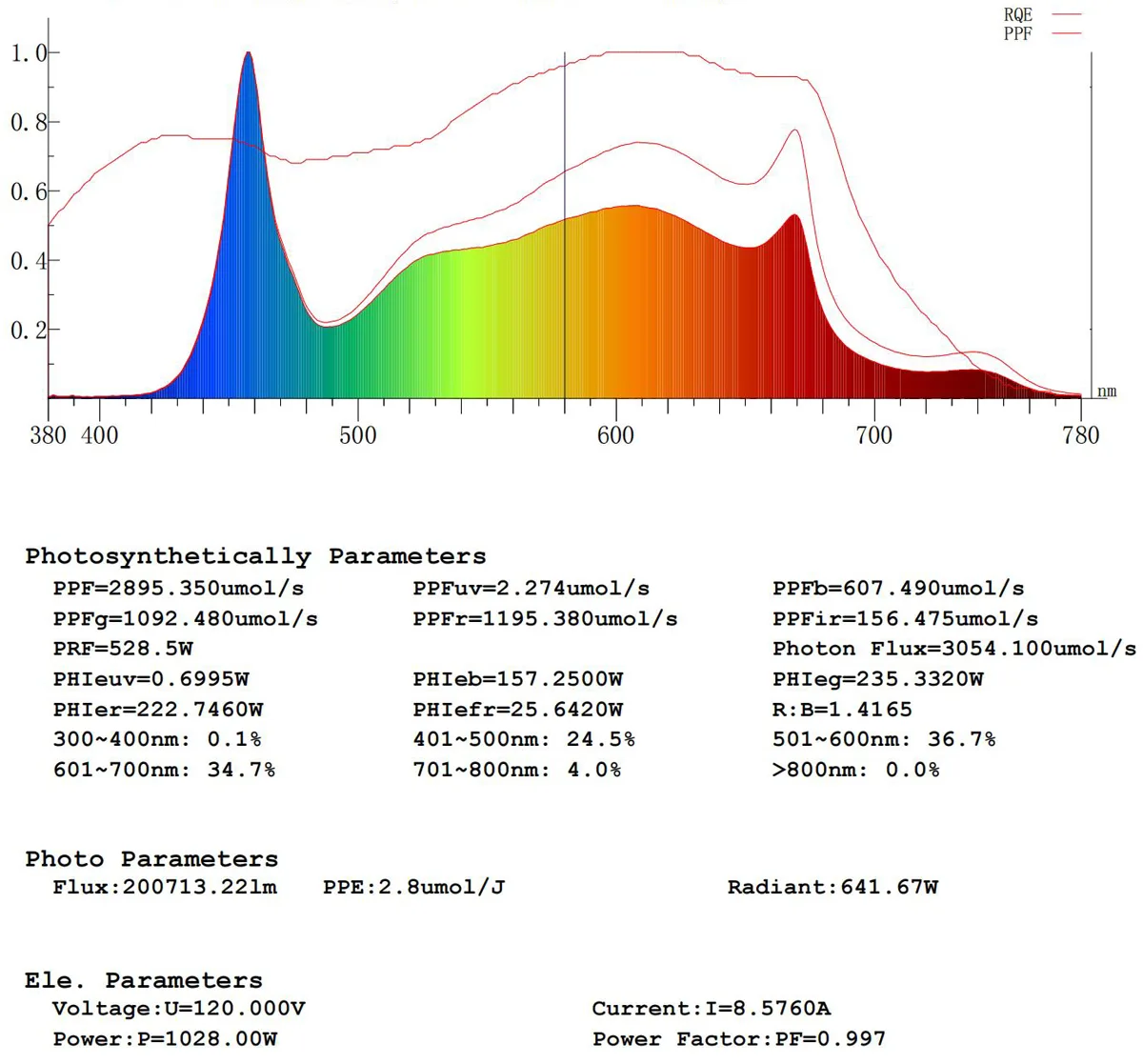
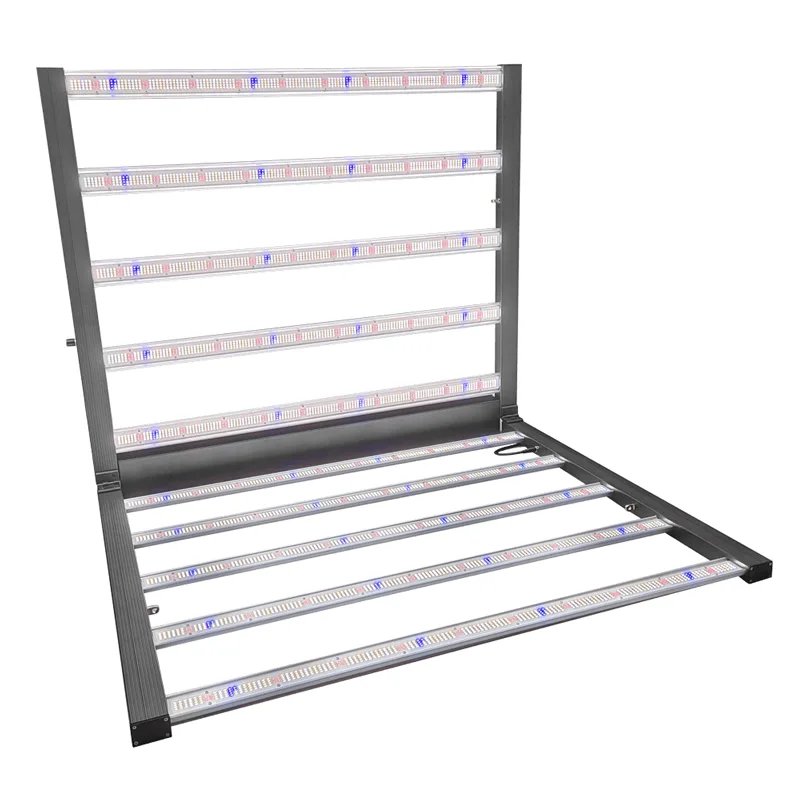
Foldable 1000W 5x8ft Core Coverage LED Grow Lights with UV IR
- Foldable fixture easy breeze to ship, store, and install, save costs
- Full spectrum with 730nm IR and enhanced 460nm blue light
- 1000W high light intensity for higher yield
- Samsung LM281 diodes and SOSEN drivers
- Compatible with UL1598/UL8800/DLC
- Knob 0-10v dimming and RJ12 integrated control
- 5 years limited warranty
What spectrum (wavelength) is required for plant lighting?

In addition to full-spectrum white light, the main spectra that promote plant growth are blue light, red light, and far-infrared light, with wavelengths of 450 nm for deep blue, 660 nm for red, and 730 nm for far-infrared. Combining these different spectra helps plants grow quickly.
Full-spectrum white light: Full-spectrum LED bulbs provide a spectrum similar to sunlight, suitable for all growth stages, and can meet plants’ comprehensive lighting needs.
Blue light: Blue light promotes chloroplast development and stem and leaf growth. It has a significant effect on the early growth stages of crops, effectively promoting root development. Blue light inhibits the growth of the main stem and leaves but promotes the thickness of the main stem. Additionally, blue light regulates organ and organelle movement, such as phototropism, stomatal opening, and chloroplast movement.
Red light: Red light significantly promotes flowering and fruiting. It increases the accumulation of chlorophyll, carotenoids, and other substances, regulates the flowering process, and enhances photosynthetic efficiency. Red light is the primary driver of photosynthesis, and in low-light environments, plants under red light exhibit the highest photosynthetic efficiency.
Far-red light: The important role of 730nm far-red light in horticultural lighting applications is that it can control the flowering cycle through 660nm and 730nm lighting. Additionally, one of its primary effects on plants is shading: if a plant is exposed to 730nm far-red light, the plant perceives that it is being shaded by a taller plant, causing it to grow more vigorously to break through the obstruction.
The Effects of Different Spectral Ranges on Plant Physiology
280-315 nm: Has minimal impact on morphological and physiological processes.
315-400 nm: Low chlorophyll absorption affects photoperiodic effects and inhibits stem elongation.
400-520 nm (blue): The highest ratio of chlorophyll to carotenoid absorption, with the greatest impact on photosynthesis.
520–610 nm (green): Low pigment absorption rate.
610–720 nm (red): Low chlorophyll absorption rate, significantly affecting photosynthesis and photoperiodic effects.
720–1000 nm: High absorption rate, stimulating cell elongation and influencing flowering and seed germination.
>1000 nm: Converted into heat.
In addition to blue and red light, other spectra, such as green, violet, and ultraviolet light, also have certain effects on plant growth. Green light helps alleviate premature leaf senescence, violet light enhances color and aroma, and ultraviolet light regulates the synthesis of plant metabolic products. These spectra work together to simulate natural light, promoting healthy plant growth.
The advantage of full-spectrum lighting lies in the far-red light, achieving a dual-light gain effect. The full-spectrum range of 400-800 nm not only includes the far-red light segment beyond 660-800 nm but also the green component at 500-540 nm. According to experiments, the green component enhances penetration, accelerates light quantum efficiency, and thus achieves more efficient photosynthesis. Based on the “dual-light gain effect,” when the wavelength exceeds 685 nm, supplementing with 650 nm red light significantly increases light quantum efficiency, surpassing the combined total of these two wavelengths when illuminated separately. This phenomenon, where two wavelengths of light enhance photosynthetic efficiency, is known as the dual-light gain effect or the Emerson effect.
Plant growth lights are designed with a reasonable wavelength ratio from 380 to 800 nm, providing plants with the optimal spectral ratio required for growth while supplementing natural light. This results in healthier and more vibrant plants, suitable for any growth stage, and effective for both hydroponic and soil-based cultivation. They are ideal for indoor gardens, potted plants, seedling propagation, breeding, farms, greenhouses, and more.
How is red-blue light mixing designed in plant growth lights?
The importance of red-blue light mixing in plant growth lights:
1. Maximizing photosynthetic efficiency
Chlorophyll a and b exhibit absorption peaks at 660nm red light and 450nm blue light wavelengths, respectively. Red-blue mixed light precisely covers the core spectrum of photosynthesis, enhancing light energy conversion efficiency by over 20%. Red light activates Photosystem II, while blue light drives Photosystem I, synergistically accelerating ATP and NADPH production during the light reaction phase, providing ample energy for the dark reaction.
Blue light enhances plant compactness by inhibiting stem elongation, promoting leaf thickening, and improving mechanical strength; red light stimulates stem elongation and accelerates reproductive growth. The combination of both achieves a balance between plant architecture and yield. Blue light promotes the accumulation of secondary metabolites (such as vitamins and anthocyanins), while red light increases soluble sugar content. Mixed light simultaneously optimizes the synthesis of nutritional and flavor compounds.
2. Different light ratios during growth stages
During the seedling stage of leafy vegetables, a high blue light ratio (4:1–7:1) is required to promote stem and leaf development. During the flowering and fruiting stages, switching to a high red light ratio (9:1) enhances yield.
3. Significant improvement in efficiency
Compared to full-spectrum light sources, red-blue mixed light focuses on effective wavelength bands, reducing energy consumption from ineffective spectra, resulting in higher biomass output per unit of electrical energy.
4. Integrated multi-dimensional effects
The intelligent control system can integrate ultraviolet wavelengths to achieve composite functions such as root development, anti-etiolation, and color enhancement for flowering. For example, succulent plants can achieve compact plant shapes and vibrant colors through dynamic dimming.
Below are common red-blue mixed light ratios for different plants, provided for design or purchasing reference:
1). Suitable for leafy vegetables or broad-leaved ornamental plants, such as lettuce, spinach, and Chinese cabbage.

2). Suitable for plants that require supplemental lighting throughout their entire growth cycle, such as succulent plants.

3). Suitable for flowering and fruiting plants, such as tomatoes, eggplants, and cucumbers.

Advantages of indoor cultivation using plant lights
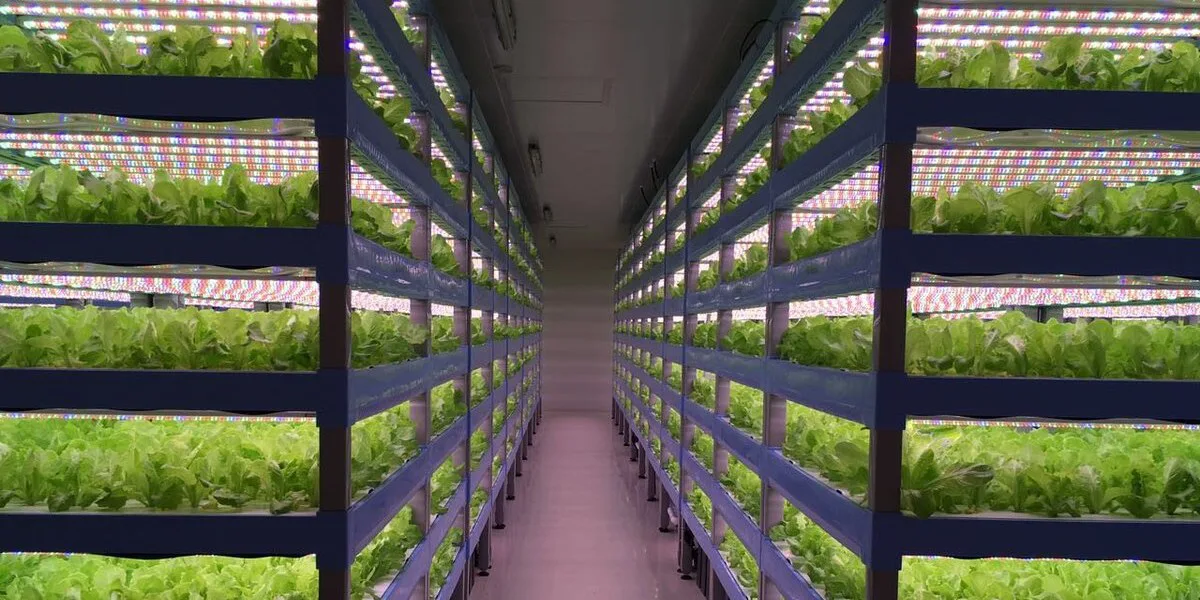
LED plant lights are a new type of plant growth light that simulates sunlight to provide plants with consistent lighting conditions, thereby meeting their nutritional requirements and lighting needs for growth. Compared to traditional natural lighting, LED plant lights offer the following advantages in cultivation:
1. The intensity and duration of light from plant lights can be controlled and adjusted at any time and place, unaffected by external factors such as weather and season, which is highly beneficial for plant growth and development.
2. The light spectrum of plant lights can be adjusted according to the specific needs of different plants, providing varying light requirements at different growth stages. This enhances plants’ absorption and utilization of the light spectrum, thereby promoting growth.
3. Compared to traditional light sources like fluorescent lamps, plant lights are more energy-efficient and environmentally friendly, with a longer lifespan of over 35,000 hours. They offer high economic and practical value.
In summary, one of the key benefits of using plant growth lights in indoor cultivation is the ability to control plant growth. By adjusting the correct spectrum, optimal light intensity, temperature, and CO₂ levels, we can achieve an excellent balance between reproductive and vegetative growth. Controlling all these growth parameters means we can truly optimize yield and quality.
Understanding the compensation point and saturation point of light in photosynthesis
Light compensation point: What exactly is the light compensation point? Simply put, it is the minimum light intensity required for plants to balance photosynthesis and respiration. Essentially, it is the plant’s break-even point. Below this point, the energy consumed by the plant exceeds the energy it produces, leading to stunted growth. Plants perform photosynthesis in the same way we eat to obtain energy. If there is insufficient light, they cannot “eat enough,” and the plants will “starve to death.”
Light saturation point: Within a certain range of light intensity, the rate of photosynthesis increases as light intensity increases. Once light intensity reaches a certain level, the rate of photosynthesis no longer increases. This intensity is the light saturation point. When the light saturation point is reached, the rate of photosynthesis is at its highest, meaning the plant grows at its fastest rate. Beyond this point, further increases in light intensity are ineffective, much like a plant that has already eaten its fill. Furthermore, prolonged exposure to light intensity exceeding the saturation point typically accelerates leaf senescence.
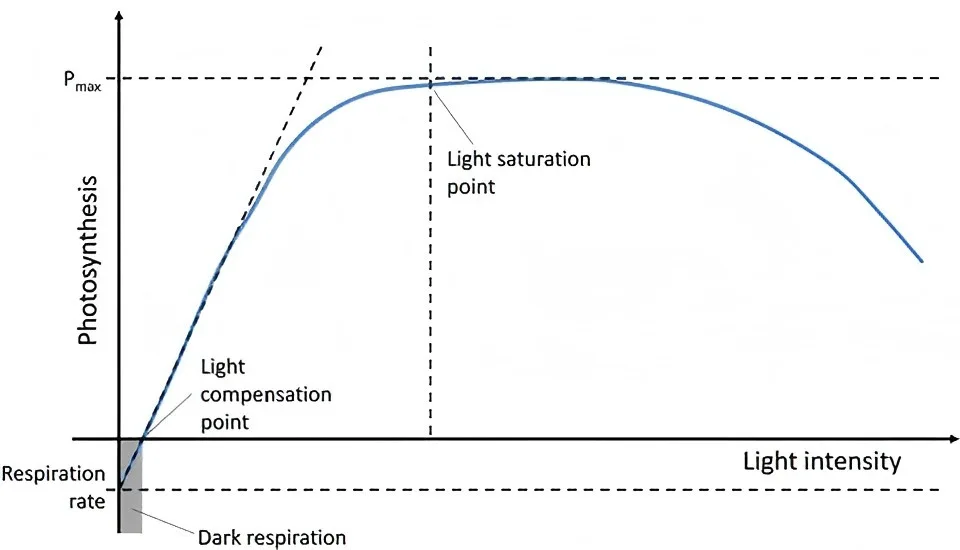
Understanding light compensation and saturation points is key to successful indoor gardening. Different plants have different light compensation points, and each plant requires a specific amount of light for growth and reproduction, meaning they all have a unique light compensation point. Light saturation points and light compensation points vary by plant species. If plants do not receive sufficient light to reach this threshold, they will not thrive. Similarly, if light exceeds this saturation point, any additional light will not promote growth and may even be harmful.
The following table lists the light compensation points and saturation points for common vegetables for reference.
| Vegetables | Light compensation point(PPFD)umol/m²/s | Light saturation point(PPFD)umol/m²/s | The maximumphotosynthesis rate |
| Cauliflower | 43 | 1095 | 17.3 |
| Cabbage | 32 | 1324 | 20.3 |
| Radish | 48 | 1461 | 24.1 |
| Chives | 29 | 1076 | 11.3 |
| Lettuce | 29.5 | 857 | 17.3 |
| Spinach | 45 | 889 | 13.2 |
| Cucumber | 51 | 1421 | 21.3 |
| Tomato | 53.1 | 1985 | 24.2 |
| Pimento | 35 | 1719 | 19.2 |
| Eggplant | 51.1 | 1682 | 20.1 |
How to supplement light for plants
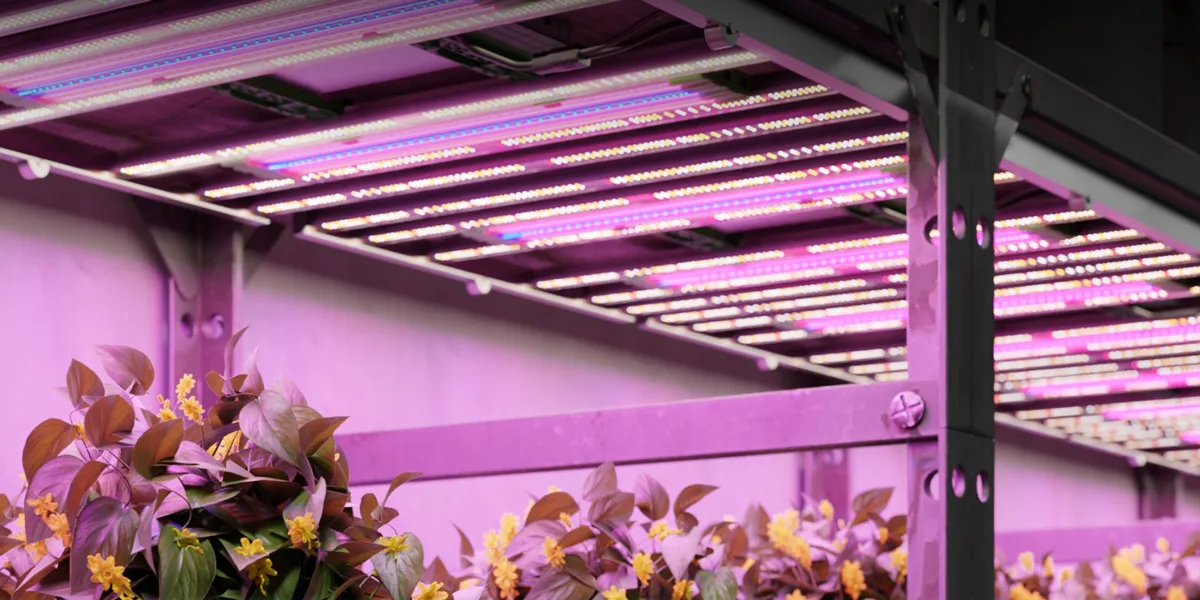
Natural light often fails to meet the needs of crops for healthy growth. By using LED plant growth lights, you can effectively control the growth trends of crops and increase yields. Whether growing vegetables, fruits, or flowers in greenhouses, vertical farming systems, or other indoor facilities, LED plant growth lights provide optimal care tailored to the specific characteristics of each crop. The LED plant growth lights produced by Sainai Optoelectronics have been proven to promote uniform and consistent growth of crops, enhancing both quality and yield.
Through experiments and research, it has been found that after supplemental lighting, the lighting environment improves, and the stem length, stem diameter, and leaf size of plants all show improvements. After supplemental lighting, the actual lighting intensity can be adjusted accordingly, and the overall light utilization efficiency is improved. As a result, crop yields increase by approximately 25%, and water utilization efficiency improves by 3.1%.
Furthermore, when using LED supplemental lighting in winter greenhouses, to maximize the effectiveness of supplemental lighting, greenhouse temperature must be appropriately controlled, which may increase heating energy consumption. This will help comprehensively optimize LED supplemental lighting strategies to enhance greenhouse production efficiency and economic benefits. The following forms of supplemental lighting are commonly used:
a) Red-blue light combination: Red light (660 nm) promotes chlorophyll synthesis and flowering/fruiting, while blue light (450 nm) enhances stem and leaf growth. Combining the two can improve photosynthetic efficiency.
b) Full-spectrum lamps: These simulate natural light and are suitable for long-term supplemental lighting needs, preventing plant elongation or reduced resistance.
c) Xenon lamps: These provide light intensity close to natural light and are suitable for high-value plants. However, they generate significant heat, consume a large amount of energy, and thus have higher costs.
On cloudy or rainy days, supplemental lighting should be provided throughout the day. On sunny days, lighting can be activated after 3-4 PM when natural light weakens, with the total daily light duration controlled between 10-12 hours. Continuous supplemental lighting exceeding 16 hours may cause light inhibition, manifested as leaf edge scorching or chlorosis.
Supplemental lighting should be conducted when the ambient temperature is ≥15°C. Low temperatures inhibit photosynthesis. During winter or when natural light is insufficient, supplemental lighting can be extended to 14 hours, but adjustments should be made based on plant species.
When natural light intensity falls below 100 μmol/m²·s, supplemental lighting should be activated to maintain PPFD (photosynthetic photon flux density) between 200 and 1000 μmol/m²·s. Use a light sensor to monitor leaf light uniformity and avoid localized over- or under-illumination. High-intensity light sources should be paired with light-blocking curtains or dimmers to prevent UV damage to leaves.
For balcony or indoor plants (such as pothos or spider plants), low-power LED supplemental lighting (8–12 hours per day) is recommended.
In greenhouses, automated systems can be integrated to dynamically adjust supplemental lighting height based on plant height, reducing energy consumption. By combining scientific lighting design with precise maintenance, green plants can maintain a glossy appearance and accelerate growth. Improvements in supplemental lighting effectiveness should be optimized in tandem with temperature and water/fertilizer management.
How to choose the right plant lights for indoor greenery?
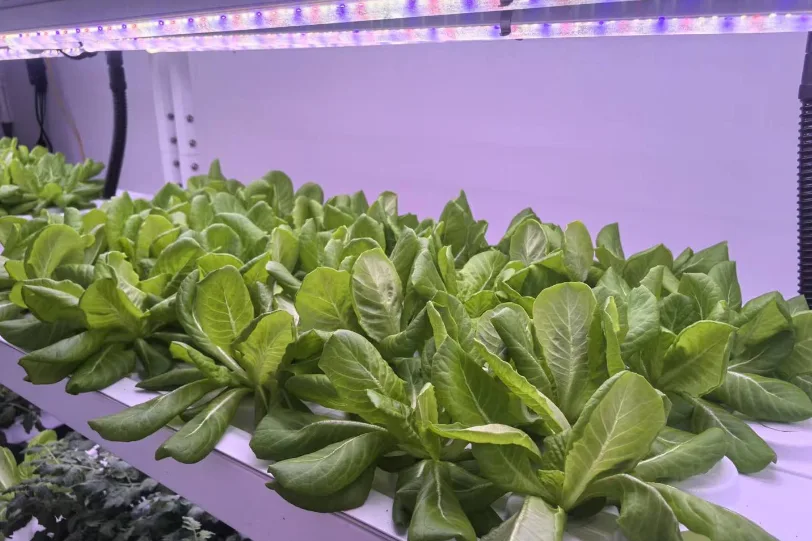
When growing a variety of crops in indoor facilities without natural sunlight, LED plant growth lights are often used to accelerate plant growth and promote healthy development. Whether you are growing vegetables or fruits indoors, LED plant growth lights can supplement natural light, enhance the light spectrum, and increase light intensity without adding extra heat.
Additionally, LED lighting can effectively enhance brightness while reducing energy consumption. Selecting plant lights suitable for leafy vegetable growth can help growers increase yield per unit area while accommodating the unique characteristics of crops, such as improving taste, enhancing nutritional value, and extending shelf life. Different lighting fixtures have varying light spectra and intensity levels, which can impact the growth and development of leafy vegetables. Generally, plant lights with a combination of blue and red light are most suitable.
Most leafy vegetables are recommended to have a red-to-blue light ratio of 4:1 during the vegetative growth stage (stem and leaf growth period). This ratio balances the promotional effect of red light on photosynthesis and the regulatory advantage of blue light on leaf morphology. For example, common leafy vegetables like lettuce and spinach can achieve efficient carbohydrate accumulation and coordinated stem and leaf growth under this ratio.
The red-to-blue light ratio for indoor leafy vegetable cultivation should be dynamically adjusted according to the cultivation stage:
1. Stage-based control scheme
Seedling stage
Blue light-dominant stage: Use a red-to-blue light ratio of 3:1 to 5:1. Increasing the blue light ratio to 30%–50% promotes root development and leaf differentiation, prevents excessive stem elongation, and significantly improves seedling vigor.
Rapid growth stage
Red light enhancement stage: Gradually adjust to a red-blue light ratio of 4:1–5:1. Increasing the red light ratio (630–660 nm) accelerates photosynthetic rates. Combined with an intensity of 200–300 μmol/m²/s, this can increase daily growth rates by over 30%.
Pre-harvest stage
Far-red light supplementation: While maintaining the 4:1 primary spectrum, a small amount of far-red light (720-740 nm) can be added.
to promote leaf expansion and cell elongation, enhancing leaf vegetable fresh weight and marketability.
2. Special requirement adjustments
Multiple-harvest varieties (e.g., chives, water spinach): Maintain the 4:1 ratio unchanged to avoid nutrient depletion.
High chlorophyll varieties (e.g., kale): Increase the blue light ratio to 25%-30% to enhance pigment synthesis.
Note: In practical applications, it is recommended to use LED plant lights with adjustable spectra and make fine adjustments based on specific varieties and cultivation environments using morphological indicators such as leaf thickness and stem hardness.
Different vegetables have varying spectral requirements at different growth stages, much like human preferences for food. For example, leafy vegetables have relatively high blue light requirements throughout their growth cycle. Blue light promotes leaf growth, making leaves greener and more lush, such as lettuce and spinach, where adequate blue light results in wider leaves and a tender texture. For fruiting vegetables like chili peppers and tomatoes, red light plays a crucial role during flowering and fruiting, stimulating flower bud differentiation and improving fruit set, resulting in larger, plumper fruits. When purchasing grow lights, it is essential to check the product’s spectral parameters and select a model that can flexibly adjust the spectral ratio to match the specific growth requirements of your vegetables.
What should be considered when using indoor grow lights?
1. Control the duration and intensity of light exposure
Light intensity (PPFD) is measured in μmol/m²・s and is a key indicator of the performance of grow lights. Leafy vegetables require adequate light exposure, but excessive light intensity or prolonged exposure can also have adverse effects on their growth.
Generally, daily light exposure should be controlled around 10–12 hours. During the seedling stage, plants are more delicate, and an intensity of 80–150 μmol/m²・s is sufficient. This intensity provides gentle care, helping seedlings grow vigorously. As vegetables enter the rapid growth stage, their demand for light intensity gradually increases, requiring approximately 200–400 μmol/m²・s of light intensity to meet their photosynthesis needs and provide sufficient energy for rapid plant growth. During the flowering and fruiting stage, some vegetables may even require light intensities exceeding 500 μmol/m²・s to promote fruit development.
Therefore, it is essential to select grow lights with adjustable light intensity ranges that meet the requirements of the vegetable’s growth stage.
The appendix is a table of recommended lighting times for common vegetables, provided for reference:
| Name | Lighting time | Effect |
| Lettuce | 10-12 | Promotes stem and leaf growth, thicker leaves. |
| Spinach | 10-12 | Promotes stem and leaf growth, making leaves more tender and green. |
| Chinese cabbage | 12-14 | Increases height, increases number of leaves, and inhibits powdery mildew. |
| Tomatoes | 11-13 | Prevents fruit deformation and promotes early ripening. |
| Cucumbers | 8-10 | Promotes early flowering and fruiting, leading to early harvest and high yields. |
| Eggplants | 10-13 | Promotes plant growth, promotes early flowering, and increases yield. |
| Green peppers | 10-12 | Promotes plant growth and prevents flower and fruit drop. |
| Watermelon | 10-12 | Promotes flowering, increases fruit yield and quality. |
| Bitter melon | 8-10 | Promotes early flowering and fruiting, produces attractive fruit. |
| Potato | 10-12 | Promotes plant growth, enhances photosynthesis, produces larger fruit. |
2. Control nutrient and water supply
While plant lights provide light for plants, nutrient and water supply are equally important. When growing lettuce, it is necessary to provide an appropriate amount of nutrient solution and water to ensure its growth and development. Appropriate supplementation of nitrogen fertilizer (such as soybean fertilizer) promotes chlorophyll synthesis, and magnesium, as a core component of chlorophyll, should be supplemented regularly.
Additionally, incorporating well-rotted nut shells (such as sunflower seed shells) into the soil can improve aeration and enhance root absorption capacity. Furthermore, ventilation and gas regulation (increasing CO₂ concentration) along with temperature and humidity control (50–70% RH) should be implemented to prevent high temperatures and humidity from causing diseases.
3. Mounting height and uniformity
Different plant lights have varying power levels, resulting in different light intensities. When selecting a light, consider the mounting height. High-power supplemental lights provide relatively high light intensity.
Generally, the closer the light source is to the plant, the higher the PPFD (photosynthetic photon flux density), allowing the plant to receive more effective light. However, as the distance from the plant light increases, while the illuminated area expands, the light intensity decreases. Plant lights without optical design have significant differences in central and edge illuminance, easily leading to uneven supplemental lighting and light waste.
Lighting fixture and plant height requirements reference:
●4-9 W, adjustable within 0.3-0.7 meters, with the main focus on covering all plants with light energy.
●9-18W, adjustable within 0.5-1.0 meters, with the main focus on covering all plants with light energy.
●18-36W, adjustable within 0.7-1.2 meters, with the main focus on covering all plants with light energy.
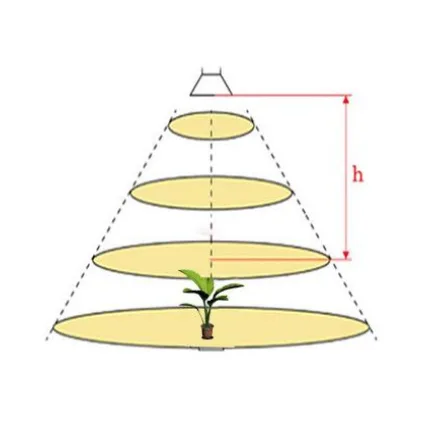
In summary, plant lights can provide optimal lighting and environmental conditions for leafy vegetable cultivation, accelerating growth rates and improving growth outcomes. The process requires careful control of lighting duration and intensity, as well as nutrient and water supply management.
Summary
For many years, SignliteLED has been dedicated to the research and development of LED grow lights for plant growth. The LED grow lights produced by SignliteLED are applicable to various crops such as cannabis, vegetables, herbs, fruits, and edible flowers, making them ideal for greenhouse vegetable cultivation and other related fields.
Specifically designed for indoor cultivation, SignliteLED has developed a T8 plant light featuring a hybrid lighting mode that combines full-spectrum daylight with supplemental lighting. This design integrates red and blue light into the full-spectrum spectrum. This design addresses the full-spectrum lighting needs of plants at all growth stages while incorporating dimming functionality, enabling precise control over light quantum output levels during different growth phases to promote rapid plant growth. Its spectral regulation capabilities, durability, and cost-effectiveness make it an ideal choice for indoor cultivation that balances performance and cost efficiency. For inquiries or further information, please contact our sales team.
